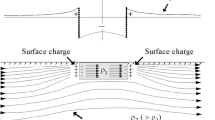Abstract
A simple acoustic decrepitometric method, with which samples of granite quartz are heated to about 600°C while the number of decrepitations are counted, has been developed to study rock samples derived from the mineralized guadalcazar granite in Mexico. Decrepitation temperatures for individual inclusions have also been determined by observing the point at which they rupture upon heating using a microscope heating stage. Decrepitation temperatures of individual fluid inclusions in granite quartz are influenced by a variety of factors notably size, shape, composition, homogenization temperature and proximity to the surface. There is a positive correlation between total decrepitation activity and fluid inclusion abundances (determined optically using point counting methods). Decrepitographs show a period of low intensity decrepitation activity below 390°C followed by a period of intensive decrepitation up to 570°C. The onset of massive decrepitation at around 390°C is constant for all samples, but variations in decrepitation activity often occur between mineralized and barren samples. These variations reflect complex differences in the fluid inclusion populations, but illustrate the potential for applying simple audio-decrepitometry as an aid to mineral exploration in granite terrains.
Similar content being viewed by others
References
Alderton, D.H.M., Rankin, A.H.: The character and evolution of hydrothermal fluids associated with the kaolinised St. Austell granite. Journ. Geol. Soc. Lond. 140:297–309 (1982)
Bowers, T.S., Helgeson, H.C.: Calculation of the thermodynamic and geochemical consequences of non-ideal mixing in the system H2O-CO2-NaCl on phase relations in geological systems: Equations of state for H2O-CO2-NaCl fluids at high pressures and temperatures. Geochim. Cosmochim. Acta 47:1247–1275 (1983)
Burlinson, K., Dubessy, J.C., Hladky, G., Wilkins, R.W.T.: The use of fluid inclusion decrepitometry to distinguish mineralized and barren quartz veins in the Aberfoyle Tin-Tungsten mine area, Tasmania. Journ. Geochem. Expl. 19:319–333 (1983)
Chryssoulis, S.L.: Development of fluid inclusion techniques and their application to Mineral Exploration with reference to selected Mexican deposits. Ph.D. Thesis (Unpublished), University of London, Imperial College (1983)
Chryssoulis, S.L., Wilkinson, N.: High silver content of fluid inclusions in quartz from the Guadalcazar granite, San Luis Potosi, Mexico: a contribution to ore genesis theory. Econ. Geol. 78:302–318 (1983)
COFFI: Fluid Inclusion Research — Proceedings of COFFI. A yearly publication of Abstracts (since 1968) of papers on, or related to, fluid inclusion studies. Roedder, E., Kozlowski, A. (eds.). University of Michigan Press
Enderby, J.L.: Decrepitation and cathodoluminescence and their use in mineral exploration at Gwynfynydd mine. M.Sc. Thesis (Unpublished), University of London, Imperial College (1985)
Ermakov, N.P.: Use of gas-liquid inclusions in prospecting and exploration for postmagmatic ore deposits and blind ore bodies. Internat. Geol. Rev. 9:947–956 (1966). Translated from Russian
Foshag, W.F., Fries, G.: Tin deposits of the Republic of Mexico. U.S. Geol. Survey Bull. 935-C:99–176 (1942)
Khetchikov, L.N., Samoilovich, L.A.: The possibilities of the decrepitation method in mineral thermometry. Izv. Akad. Nauk. SSSR, Series Geology 7:92–98 (1970). English Translation in COFFI, 3:94–100
Kostyleva, Y.Y., Labuntsov, V.A.: Studies of the decrepitation of quartz and universal decrepitation amplifier recorder. In: Research on the nature of mineral forming solutions (N.P. Ermakov, ed.), 578–608. Pergamon Press, London (1985)
Leroy, J.: Contribution to the evaluation of internal pressure in fluid inclusions. Bull. Soc. Franç. Minéral. Cristallogr., 102:584–593 (1979)
Potter, R.W., Brown, D.L.: The volumetric properties of aqueous sodium chloride solutions from 0° to 500°C at pressures up to 2 000 bars based on a regression of available data in the literature. U.S. Geol. Surv. Bull. 1421-C:36 pages (1977)
Pulou, R., de Croizant, J., Gritti, C.: Enregistreur décrépitometrique appliqué à la détermination des températures dépôt des minéraux. Schweiz. Mineral. Petr. Mitt. 50:59–66 (1970)
Rankin, A.H., Alderton, D.H.M.: Fluid inclusion petrography of S.W. England granites and its potential in mineral exploration. Mineral. Deposita 18:335–347 (1983)
Roedder, E.: Fluid inclusions as tools in mineral exploration. Econ Geol. 72:503–525 (1977)
Roedder, E.: Fluid inclusions. Min. Soc. Amer. Revs. in Mineralogy. Vol 12:644 pages (1984)
Roedder, E., Bodnar, R.J.: Geologic pressure determinations from fluid inclusion studies. Annual Revs. Earth Planet. Sci. 8:263–301 (1980)
Salas, G.P.: Carta y provincias metallogenticas de La Republica Mexicana. Consejo. Rec. Minerales. Bull. 21 E:242 (1975)
Shatagin, N.N., Dorogovin, B.A., Khetchikov, L.N.: Regression analysis and the dependence of the temperature of decrepitation of gas-liquid inclusions on their size, distance from the edge of the grain and the pressure of mineral formation. Geologiya Rudnykh Mestorozh., 20:75–83 (1978). English translation in COFFI, 11:264–272 (1978)
Shepherd, T.J.: Temperature-programmable heating-freezing stage for microthermometric analysis of fluid inclusions. Econ. Geol. 76:1244–1247 (1981)
Shepherd, T.J., Rankin, A.H., Alderton, D.H.M.: A practical guide to fluid inclusion studies. Blackie and Sons, Glasgow, 239 pages (1985)
Smith, F.G., Little, W.M.: Sources of error in the decrepitation method of study of liquid inclusions. Econ. Geol. 47:233–238 (1953)
Tugarinov, A.N., Naumov, V.N.: Dependence of decrepitation temperature on the composition of gas-liquid inclusions and mineral strength (In Russian). Akad. Nauk. SSSR Doklady 195:182–184 (1970). English Translation in COFFI, 3:129–131 (1970)
Urusova, M.A.: Volume properties of aqueous solutions of NaCl at elevated temperatures and pressures. Russian Journal of Inorg. Chem. 20:1717–1721 (1975). In English, translated from Russian
Author information
Authors and Affiliations
Rights and permissions
About this article
Cite this article
Chryssoulis, S.L., Rankin, A.H. Decrepitometry of fluid inclusions in quartz from the guadalcazar granite of Mexico; principles and application to mineral exploration. Mineral. Deposita 23, 42–49 (1988). https://doi.org/10.1007/BF00204227
Received:
Accepted:
Issue Date:
DOI: https://doi.org/10.1007/BF00204227




